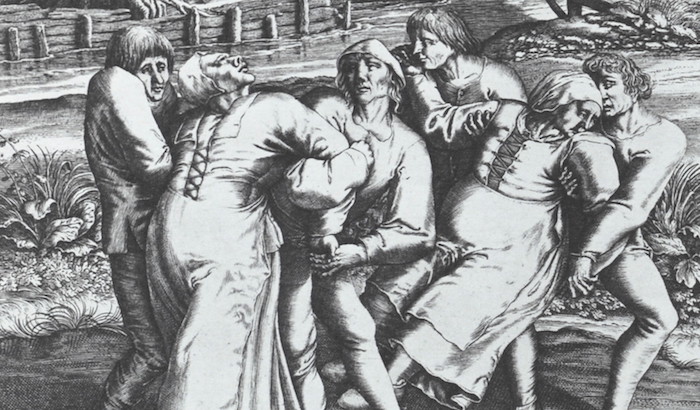Once a month here on the Molten Sulfur Blog, I run content taken from our book Archive: Historical People, Places, and Events for RPGs. This post, about the Dancing Plague of 1518, is one of eighty entries in Archive, each more gameable than the last!

The Dancing Plague of 1518
A Bad Case of Hot Blood
Amid the narrow lanes, shops, and fairs of the medieval city of Strasbourg, France, Frau Troffea stepped into the street and began to dance. There was no music in the air, and her face was contorted in a pained expression. She danced the whole day. As the sun began to set behind half-timbered houses, it became clear that Frau Troffea could not stop. Her skirts flew up around her rapidly moving legs, her skin was bathed in sweat, and her muscles were twitching. Only after hours upon hours of dancing did she finally collapse from exhaustion, sinking into a brief sleep in the middle of the street. Her slumber lasted only a few hours, and then she resumed to dance. Within days, the epidemic spread to more than thirty people, who also took to the streets to dance.
The dancing mania struck Strasbourg in July of 1518, and cases of it spiked by August. People danced in the streets for days without rest. Local authorities believed those suffering from the plague would only recover if they danced day and night. Because of this theory, town halls were set aside for them to dance in rather than the streets, musicians were hired to play to their dancing, and professional dancers were hired to keep the afflicted on their feet. Within days, the literally weak-hearted began to die from heart attack, stroke, or exhaustion. By the end of August, about 400 people had experienced the plague, some having danced themselves to death.
Religious ceremonies were held in attempt to exorcise demons thought to be causing the mania, and people commonly prayed to St. Vitus for aid. Through this, St. Vitus became the patron saint of dancers. Physicians’ notes, cathedral sermons, regional chronicles, and memos issued by the Strasbourg city council confirm that the victims were dancing, not just moving sporadically. It is still a mystery why people were dancing themselves to death, nor is it clear whether they were dancing willingly. As the plague spread to more people, concerned nobles sought advice from local physicians. They ruled out astrological and supernatural causes, and instead announced that the plague was a natural disease brought about by hot blood.
A more modern theory is the plague was caused by mass psychogenic illness, a manifestation of mass hysteria often preceded by extreme levels of psychological distress. Famine, smallpox, syphilis, and leprosy afflicting the populace could have caused wide-spread psychological distress triggering the illness. Another theory is the plague was brought about by an outbreak of ergotism, which is an illness caused by eating a psychotropic mold that grows on rye bread. It causes delirium, hallucinations, and seizures.
There were several other outbreaks of the dancing epidemic in medieval Europe as well, mostly in the areas around Strasbourg. A major outbreak happened more recently in 1840s Madagascar where people were reportedly dancing wildly, in a state of trance, and convinced that they were possessed by spirits.
The Dancing Plague in Play
Of all the diseases someone could contract in a campaign, the dancing plague is certainly one of the more memorable. Imagine one of your PCs or NPCs dancing wildly in the middle of town, or even in a dungeon, and the party scrambling to find a cure. They could go to a physician for aid, only to receive a possible diagnosis without any cure attached. Or they could try a priestess who might offer spiritual aid. Maybe the afflicted character did eat a hallucinogenic mold that could add to their list of symptoms. Maybe the medieval physicians in Strasbourg were wrong, and a trickster or a demon is possessing the subject out of boredom. Either way, the party should be cautious. As seen in 1518, the dancing mania spreads fast.






